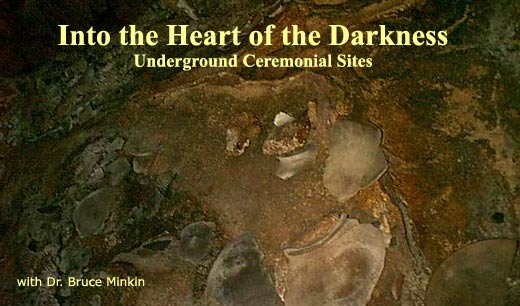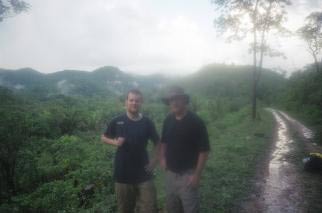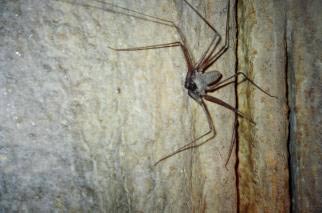The
year was 750 A.D. At a time when London was just a collection
of wooden huts, the vast metropolis of Tikal flourished in the
jungles of Guatemala. It was a thriving city of 40,000 people
and covered an area the size of Manhattan. And yet, less than
a century later, it stood empty. All over the Mayan empire the
cities were deserted rather than destroyed. It was as if they
walked into the forest, never to return.
In a period lasting from 250-900A.D., the sophisticated society we call the Classic Maya would flourish. Hundreds of city-states were created. The vast territory that is now Southen Mexico, Belize, Guatemala, and Honduras became the empire of the Maya. When Europe was still in the Dark Ages, The Mayan culture produced artists and scientists whose achievements still astound us. Highly developed mathmatics was closely tied to a complex system of astronomy. The detailed observations of the nightsky were reported with amazing accuracy. A thousand years before the first computer, they recorded events eons in the past. The cycles of the moon were mapped so precisely that today their calculations are only off by 33 seconds! They developed an elaborate system of hieroglyphic writing to record their history. Some of the greatest feats of decoding have occured in the last few years to unlock the secrets of the Mayan culture. |
||
controlled the daily life of the Maya on the surface. It is only in the last 10 years that the importance of these underground ceremonial sites has come to light. A new breed of archeologists has come to the forefront. Armed with ropes, lights, surveying equipment and a sense of adventure, these scientists are probing deeper into the caves of Belize to unlock their secrets. They have adapted the techniques of surface archeology to the dark and dangerous world of Xiabalba. It is in this forbidding realm that new insights of the Maya are coming to light. But there are mysteries that are still buried in the caves of Belize. What would you do to find out? I have been working with the Western Belize Regional Cave Project (WBRCP) for five years. This group has been studying the importance of caves to the ancient Maya. Scientists from all over the world congregate in western Belize to investigate the underground ceremonial sites. It is an amazingly diverse group, each person bringing their own expertise in their field of interest. Even within the specialized focus of cave archeology, it is common to meet a hieroglyphic expert from Finland, a ceramic authority from Japan or a human bone specialist from Canada. |
||
My particular interest lies in cave exploration and reconnaissance. I have been caving since I was 9 years old and developed the skills of vertical cave climbing. This technique is especially useful in exploring the caves used by the Maya. The ancient Maya went to extraordinary measures to hide their ritual sites. For example, one of the caves that we discovered had a 120 foot pit entrance. The underground chamber was the size of a basketball arena! Getting in and out of this cave required freefall rappeling and ascending using special vertical climbing rigs. At the bottom, we found a small grotto filled with delicate pottery vessels. How the Mayans were able to access this site and leave such beautiful artifacts intact is truly a mystery! Looting of Mayan artifacts is a huge problem in Belize. This is especially true in the caverns used by the Maya. Oftentimes, the urns and human bones are lying in the open exactly as they were 1000 years ago. Once these artifacts have been disturbed, the scientific importance has been lost. Our goal as archeologists is to get to these sites, record and preserve the artifacts before they are stolen. With the aid of vertical cave techniques, we have been able to reach pristine , undiscovered ritual sites to study before the looters found them. As part of this process of finding potential sites in the jungle for preservation, we have turned to advanced technology to help us out. For the past 3 years, I have been assisting Cameron Griffith in a project to identify caves hidden in the jungle by using satellite and radar. Images from space can detect subtle changes in temperature, vegetation and elevation. By matching these differentials with a GPS point, we can locate sinkholes deep in the rainforest. Of course, this new age technology is of no use sitting on a computer. The sites must be "ground-truthed" or checked out on foot. Imagine carrying a 50 pound backpack through almost impassable bush following the GPS signals for hours. You finally reach the waypoint but all you see is a thick clump of vines. But sure enough, you crawl into the brush and find a 30 foot sinkhole! The radar pinpointed the pit within one meter! We would have walked right past it. With the help of dedicated scientists and advanced technology, there is a chance that these wonderful Mayan sites will be preserved for the world to see. |
||
Bruce I. Minkin, M.D., is a practicing hand surgeon from Asheville, North Carolina. He has been caving since he was 9 years old, and has been a member of the National Speleogical Society since 1960. When he was 16, the Mexican government of Campeche invited him to help excavate some Maya burial caves in the jungles of the Yucatán, starting him on a lifelong quest for adventure. Bruce
graduated from the University of Tennessee with a B.A. in physical
anthropology, then attended medical school. Throughout his studies
and practice, Bruce has continued his interest in the outdoors,
and his passion for archaeology and caving led him to the Belize
Valley Archaeological Reconnaissance project in 1998. Even though
he is not a professional archaeologist, he was accepted as a crew
member because of his experience with vertical caving and anthropology.
The next year he returned with his son Erik, who did his senior
project on Maya cave archaeology. |
All
photos provided by Dr. Bruce Minkin. All rights reserved. |




